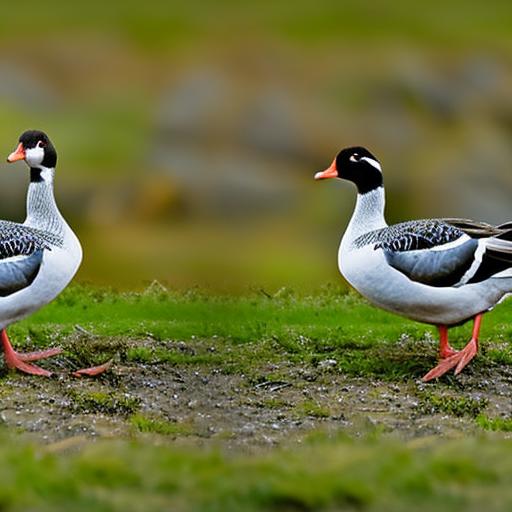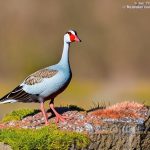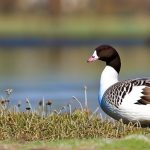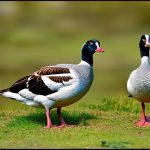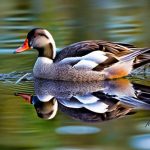Pilgrim geese are a breed of domesticated geese that originated in the United States. They are known for their calm and friendly temperament, making them popular among farmers and hobbyists alike. The breed was developed in the early 20th century by Oscar Grow, who crossed Chinese and European geese to create a breed that was hardy and good for both meat and egg production.
The breeding season is a crucial time for Pilgrim geese, as it is during this time that they reproduce and ensure the survival of their species. It is important for farmers and breeders to understand the breeding season of Pilgrim geese in order to successfully raise and maintain a healthy population.
Key Takeaways
- Pilgrim geese are a domesticated breed of geese that are known for their calm and friendly nature.
- During breeding season, male Pilgrim geese develop a distinctive knob on their beak and their feathers become more vibrant in color.
- Factors that can affect Pilgrim geese breeding season include temperature, daylight hours, and the availability of food and water.
- Pilgrim geese typically lay their eggs in a nest that they build on the ground, and they can lay up to 40 eggs per season.
- The incubation period for Pilgrim geese eggs is around 28-32 days, and goslings are able to walk and swim within hours of hatching.
Physical Characteristics of Pilgrim Geese During Breeding Season
During the breeding season, both male and female Pilgrim geese undergo physical changes. The most noticeable change is in their plumage. Male Pilgrim geese, also known as ganders, develop a larger and more prominent knob on their beak. They also develop a more vibrant coloration on their feathers, with shades of gray, white, and brown becoming more pronounced.
Female Pilgrim geese, or geese, also experience changes in their appearance during the breeding season. Their feathers become brighter and more vibrant, with shades of gray and white becoming more pronounced. They also develop a larger and rounder body shape, which is necessary for carrying and laying eggs.
Factors Affecting Pilgrim Geese Breeding Season
Several factors can affect the breeding season of Pilgrim geese. Environmental factors such as temperature, daylight hours, and weather conditions can play a significant role in determining when geese will start breeding. Geese are more likely to breed during the spring months when temperatures are mild and there is an abundance of food and water.
The age and health of the geese also play a role in their breeding season. Younger geese may not reach sexual maturity until they are around two years old, while older geese may have a decline in fertility. It is important to ensure that the geese are in good health and have access to a balanced diet to maximize their chances of successful breeding.
The availability of food and water is another important factor that can affect the breeding season of Pilgrim geese. Geese require a diet that is rich in nutrients, especially during the breeding season when they need to produce eggs and care for their young. Access to clean and fresh water is also crucial for the health and well-being of the geese.
Nesting and Egg Laying Habits of Pilgrim Geese
Pilgrim geese are known for their strong nesting instincts. They will often build their nests in secluded areas, such as tall grass or shrubs, to protect their eggs from predators. The female goose will line the nest with feathers and down to provide insulation and comfort for the eggs.
Female Pilgrim geese typically lay around 20-30 eggs per breeding season. The eggs are large and white in color, with a smooth shell. The female will lay one egg every other day until she has completed her clutch. Once all the eggs have been laid, she will begin incubating them.
The incubation period for Pilgrim goose eggs is approximately 28-34 days. During this time, the female will sit on the nest and keep the eggs warm. She will rotate the eggs regularly to ensure even heat distribution and prevent them from becoming damaged.
Incubation Period and Hatching of Pilgrim Geese Eggs
The incubation period for Pilgrim goose eggs is approximately 28-34 days. During this time, the female goose will remain on the nest, keeping the eggs warm and providing them with the necessary heat for development. It is important to provide a quiet and undisturbed environment for the female during this time to ensure successful hatching.
Signs of hatching can be observed towards the end of the incubation period. The eggs may start to make cracking sounds as the goslings inside begin to break through the shell. The female will continue to sit on the nest until all the eggs have hatched.
Once the goslings have hatched, they will be wet and covered in down feathers. The female will help them dry off by fluffing her feathers and providing warmth. It is important to provide a safe and warm environment for the goslings after hatching to ensure their survival.
Raising Pilgrim Goslings During Breeding Season

Raising Pilgrim goslings during the breeding season requires special care and attention. The goslings will need to be fed a balanced diet that is rich in nutrients to support their growth and development. They should be provided with a starter feed that is specifically formulated for waterfowl.
In addition to proper nutrition, it is important to provide shelter and protection for the goslings. They should be kept in a secure enclosure that is protected from predators and extreme weather conditions. The enclosure should also have access to clean and fresh water for the goslings to swim and bathe in.
Socialization with other geese is also important for the goslings’ development. They should be allowed to interact with adult geese and learn from their behaviors. This will help them develop social skills and establish a hierarchy within the flock.
Behavioral Changes in Pilgrim Geese During Breeding Season
During the breeding season, Pilgrim geese undergo several behavioral changes. Mating behavior becomes more prominent, with males displaying courtship rituals such as head bobbing, wing flapping, and honking. They may also become more aggressive towards other geese, especially if they perceive them as a threat to their mate or nest.
Female geese become more protective of their eggs and goslings during the breeding season. They will aggressively defend their nest and young from predators or other geese that come too close. It is important to provide a safe and secure environment for the geese during this time to minimize stress and aggression.
Health and Nutritional Requirements of Pilgrim Geese During Breeding Season
Proper nutrition is crucial for the health and well-being of Pilgrim geese during the breeding season. They require a balanced diet that is rich in nutrients, including protein, vitamins, and minerals. A diet that consists of a mix of grains, greens, and protein sources such as insects or fish will help support their reproductive health and ensure successful breeding.
During the breeding season, geese may be more susceptible to certain health issues. Common issues include egg binding, where the female is unable to lay her eggs, and respiratory infections. It is important to monitor the geese closely for any signs of illness or distress and seek veterinary care if necessary.
Preventative measures such as regular vaccinations, deworming, and providing a clean and sanitary environment can help minimize the risk of health issues during the breeding season. It is also important to provide access to clean and fresh water at all times to prevent dehydration.
Tips for Successful Breeding of Pilgrim Geese
To ensure successful breeding of Pilgrim geese, there are several tips that can be followed:
1. Provide a suitable environment: Geese need a quiet and undisturbed environment for breeding. Provide them with a secluded area where they can build their nests and lay their eggs.
2. Monitor geese for signs of illness or stress: Regularly check the geese for any signs of illness or distress. This includes changes in behavior, appetite, or appearance. Seek veterinary care if necessary.
3. Properly care for eggs and goslings: Provide a safe and warm environment for the eggs and goslings. Ensure they have access to proper nutrition, clean water, and protection from predators.
The Importance of Breeding Season for Pilgrim Geese Population
The breeding season is a crucial time for Pilgrim geese as it ensures the survival and growth of their population. Understanding the physical characteristics, nesting habits, and behavioral changes during this time is essential for successful breeding. Providing a suitable environment, monitoring the geese for signs of illness or stress, and properly caring for the eggs and goslings are important factors in ensuring a healthy and thriving population of Pilgrim geese. By following these guidelines, breeders and farmers can contribute to the conservation and preservation of this unique breed.
If you’re interested in breeding season pilgrim geese, you might also find this article on turning a shed into a chicken coop helpful. It provides valuable insights and tips on how to convert a shed into a suitable living space for your geese. Check it out here. Additionally, if you’re looking for information on what to feed your geese, this article on what you should feed ducks could be beneficial. Geese and ducks have similar dietary needs, so the advice provided in the article can be applied to your pilgrim geese as well. Read more here.
FAQs
What are Pilgrim geese?
Pilgrim geese are a domestic breed of geese that are known for their calm and friendly temperament. They are medium-sized birds with white feathers and a distinctive knob on their bills.
When is breeding season for Pilgrim geese?
Breeding season for Pilgrim geese typically begins in late winter or early spring, depending on the climate and location. The birds will begin to mate and lay eggs during this time.
How do Pilgrim geese mate?
Pilgrim geese mate through a process called cloacal kissing, where the male and female press their cloacas together to transfer sperm. The female will then lay eggs that will hatch into goslings.
How many eggs do Pilgrim geese lay during breeding season?
Pilgrim geese typically lay between 20-40 eggs per breeding season, with each egg taking around 28-30 days to hatch.
What is the incubation period for Pilgrim geese eggs?
The incubation period for Pilgrim geese eggs is around 28-30 days. During this time, the female will sit on the eggs to keep them warm and protect them from predators.
What is the lifespan of Pilgrim geese?
Pilgrim geese can live for up to 10-15 years in captivity, depending on their living conditions and level of care. In the wild, their lifespan may be shorter due to predation and other factors.
What is the average weight of a Pilgrim goose?
The average weight of a Pilgrim goose is around 10-12 pounds for males and 8-10 pounds for females. However, this can vary depending on factors such as age, diet, and genetics.
Meet Walter, the feathered-friend fanatic of Florida! Nestled in the sunshine state, Walter struts through life with his feathered companions, clucking his way to happiness. With a coop that’s fancier than a five-star hotel, he’s the Don Juan of the chicken world. When he’s not teaching his hens to do the cha-cha, you’ll find him in a heated debate with his prized rooster, Sir Clucks-a-Lot. Walter’s poultry passion is no yolk; he’s the sunny-side-up guy you never knew you needed in your flock of friends!

